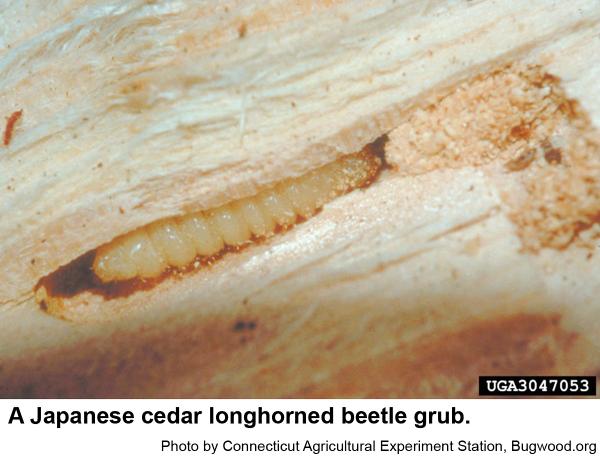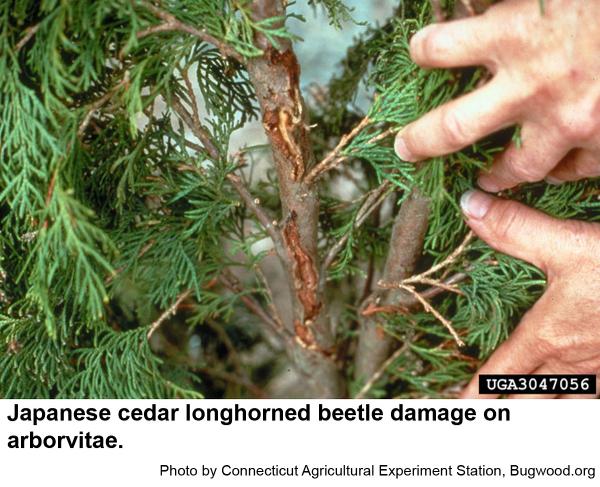Description
The Japanese cedar longhorned beetle, Callidiellum rufipenne, is also called the smaller Japanese cedar longhorned beetle, the small Japanese cedar longhorned beetle, or the Japanese cedar longhorn. They are about 5/8 inch long. Japanese cedar longhorned beetle males are deep blue to black and have antennae longer than their bodies. Females have reddish brown wings and antennae shorter than their bodies. Mature grubs are legless and slender with constrictions between their abdominal segments so that their bodies vaguely resemble elongate rattle snake rattles. Grubs have a segment just behind their heads that is wide and somewhat flattened.
Biology
Japanese cedar longhorned beetles have one generation per year. Females lay eggs in bark crevices over their 20 day life span. Females usually begin to lay eggs from 1 to 3 days after emergence from the host tree. Females seem to be able to lay eggs without feeding beforehand. The larvae bore into the bark and construct shallow galleries after hatching. They feed on the phloem and cambium layers. Then the fully mature larvae enter the xylem to begin pupation. They overwinter as adults and then chew through the bark to emerge in early spring.
Host Plants
Larvae bore into coniferous trees of the cypress family. Major hosts include arborvitae, cypress, juniper, and cedar (Chamaecyparis). Young grubs tunnel just beneath the bark. These tunnels are packed with dark brown frass. Older grubs bore right into the wood and pack their tunnels with pale frass. New adult Japanese cedar longhorned beetles bore out of their host plant leaving a distinctly oval hole.
Residential Recommendations
Because Japanese cedar longhorned beetle grubs pack their tunnels with frass, spraying an infested tree is not likely to kill grubs inside. To prevent further attacks, plants in the cypress family should be treated with a pyrethroid in early March and again in early April. (Doing so will likely protect plants from cypress weevils as well.) Several pyrethroid insecticides are available in plant centers and big box stores (Look for an active ingredient that ends with "-thrin." Active ingredients are listed on the front often in very tiny font toward the bottom of the container.). When used as directed, pyrethroids are very toxic to insects but are not particularly hazardous to humans and pets (other than fish-avoid using pyrethroids around pools, ponds, and streams).
Other Resources
- Japanese cedar longhorned beetle. Anonymous. 2008. Massachusetts Department of Agricultural Resources.
- Japanese cedar longhorned beetle, Callidiellum rufipenne. Anonymous. 2010. Michigan State University’s invasive species factsheets.
- Japanese cedar longhorn beetle, Callidiellum rufipenne (Motschulsky, 1860). Anonymous. No Date. Invasive.org
- Japanese Cedar Longhorned Beetle in the Eastern United States. Hoebeke, E. R. 1999. USDA APHIS Pest Alert.
- Extension Plant Pathology Publications and Factsheets
- Horticultural Science Publications
- North Carolina Agricultural Chemicals Manual
For assistance with a specific problem, contact your local N.C. Cooperative Extension Center.
This Factsheet has not been peer reviewed.
Publication date: Oct. 26, 2018
Reviewed/Revised: Sept. 25, 2019
Recommendations for the use of agricultural chemicals are included in this publication as a convenience to the reader. The use of brand names and any mention or listing of commercial products or services in this publication does not imply endorsement by NC State University or N.C. A&T State University nor discrimination against similar products or services not mentioned. Individuals who use agricultural chemicals are responsible for ensuring that the intended use complies with current regulations and conforms to the product label. Be sure to obtain current information about usage regulations and examine a current product label before applying any chemical. For assistance, contact your local N.C. Cooperative Extension county center.
N.C. Cooperative Extension prohibits discrimination and harassment regardless of age, color, disability, family and marital status, gender identity, national origin, political beliefs, race, religion, sex (including pregnancy), sexual orientation and veteran status.





